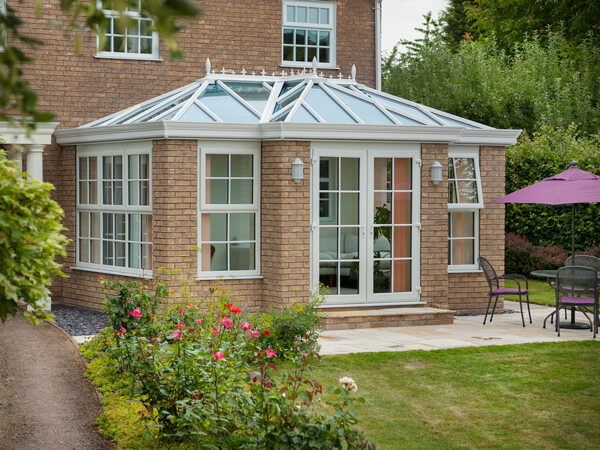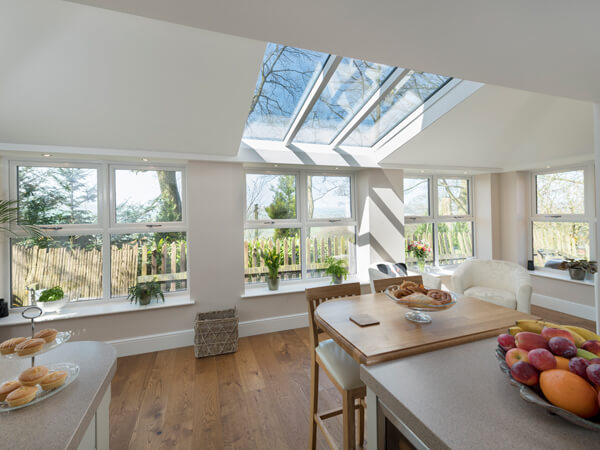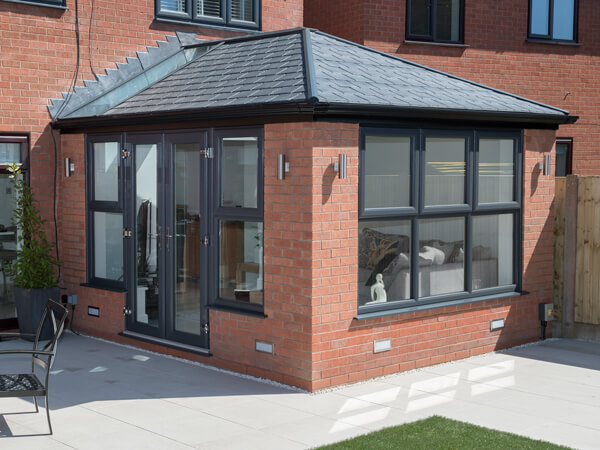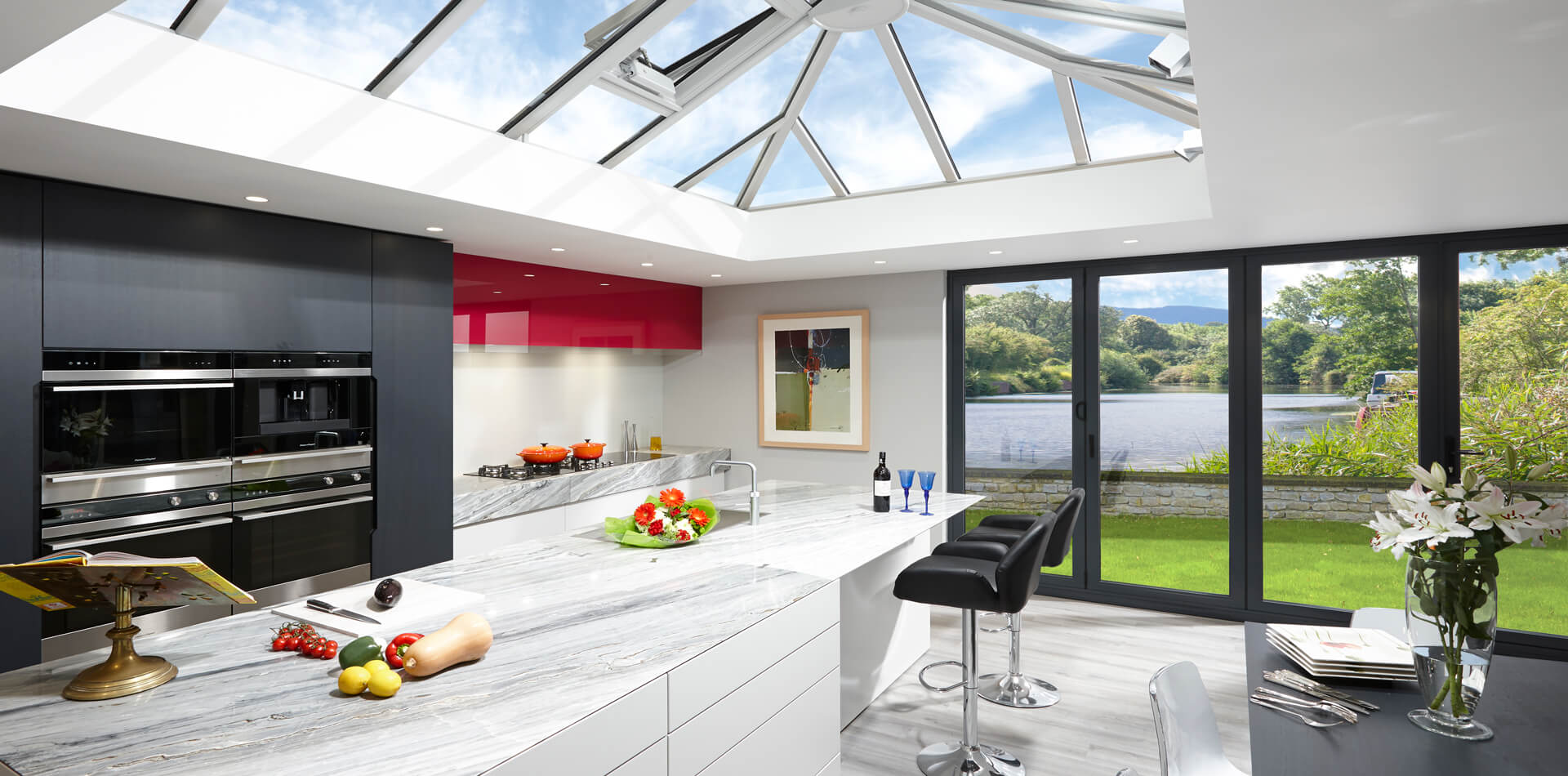Can you tell me the difference between conservatories, orangeries, and extensions?
This is a common question and if we’re honest, things are now so blurred that a living space can be anything you like. A conservatory would traditionally and predominantly consist of glass – a glass roof, glass walls etc. to leave you with the most wonderful garden and aerial view. Things have changed a little though thanks to the creation of the tiled roof conservatory, complete with dwarf walls, for the most superb insulation. We can also provide solar control glazing for your space so that the weather cannot interfere with it.
Orangeries, on the other hand, tend to include brick or aluminium pillars, which makes them slightly more secluded and gorgeously cosy inside. They also generally have a pelmet around the roof’s perimeter, contributing to the overall thermal insulation of the space. As for its roof, you can have a glass lantern, solid tiled roof, or a mix of the two.

A home extension is designed to be more of a natural extension of a property so that it blends in effortlessly. It will have a solid feel due to its brickwork and very often include some type of solid tiled roof. However, you can have a hybrid roof that features full length glass panels and / or Velux windows if you’re keen for it to receive plenty of natural light and ventilation. Extensions are great year-round settings as they can keep the weather firmly out.
It doesn’t really matter how you define an extension. Begin work on planning yours with a Trent Valley advisor.

Would you recommend a tiled or glass roof?
That will come down to how the room will be used, what direction it will face and the money you have available to spend. If you value natural light and external views, the great news is that solar control glazing is so advanced nowadays and there are many glazing products on the market to keep the space consistently well-insulated.
A solid tiled roof will be a leading contender if you wish to have a year-round space as it can incorporate full length glass panels or Velux windows to make it a crossover of a solid and glass roof. This will give you the benefits of both.
Gain further advice on roofing solutions from a Trent Valley consultant.

MORE COMMON QUESTIONS
We encourage customers to speak to an advisor if they have any questions. Here are some very common questions that they often receive.
Will it be unusable in summer and winter?
Not if it’s bought from Trent Valley Windows, as all our living spaces are designed for year-round use. Whereas designs with old polycarbonate roofs would feel like greenhouses in the peak of summer, a modern extension with solar control glazing will be anything but that, particularly if it has a tiled roof covering attached to it.
Do you make your roofing systems?
We do, as Trent Valley Windows is a Premium Retailer of the Conservatory Outlet Group, and its sister company, Conservatory Outlet, is one of the UK’s foremost roof manufacturers. They are built in Conservatory Outlet’s state-of-the-art manufacturing facility located in Wakefield, West Yorkshire.
Being so closely aligned to our manufacturing company helps us to monitor our supply chain and check that our roofing systems match our expected standards.
Is it OK to have contrasting roof tiles?
That won’t be a problem. You can select from a series of shingle and slate roof tiles, and if you want us to, we can ensure they match the tiles on the roof of your house. Flat roof membranes are also offered. Find out more via a Trent Valley advisor.
What are ‘A’ energy rated windows?
The BFRC Rating Scheme ranks ‘A’ rated windows as the most energy efficient windows on sale in the UK and is the system used to highlight the energy efficiency of all replacement window designs. Knowing the energy efficiency levels of replacement windows helps you to recognise what they will deliver and whether they comply with Building Regulations.
The window energy rating system is very much like the traffic-light system used for white goods e.g., washing machines, freezers, and fridges. With windows energy rated from A-E.
Energy labelling tells you what you are getting for your money and helps you make a more informed decision when buying new windows.
What is solar control glazing?
Solar control glazing has a clever coating on the glass which does the job of stopping too much warmth from entering and escaping from the space. It can be tinted in different ways and your chosen tint will be based on the amount of light transmission and heat retention you want to achieve.
Is it possible to match to my existing bricks?
Our team will try and source the closest matching brick that they can find and present it to you ahead of any work commencing. We make a point of telling customers that there can be weathering differences between new and existing bricks. If unsatisfied with our proposed brick match, you can request that the new brickwork is tinted to suit, but please note that this will incur an additional charge.
Will Building Regulations Approval be required?
It is necessary for most extensions of properties, but certain classes of extension don’t need Building Regulations Approval. The situation will be clarified by one of Trent Valley’s surveyors. Each of our surveyors have great knowledge of planning and building regulations and will guide you through the process. If Building Regulations Approval needs to be obtained, we can assist with this.
Do I need planning permission?
As it’s considered to be a permitted development, an extension or addition to your house should not require an application for planning permission. However, the below typical conditions must be met:
- The ground area covered by the extension and any other buildings within the boundary of the property, excluding the original house, is not more than half the total area of the property.
- Any part of the extension is not higher than the highest part of the roof of the existing house.
- The eaves of the extension are not higher than the eaves of the existing house.
- Any part of the extension does not extend beyond any wall facing a road if it forms the principal or side elevation of the original house.
- The eaves are no more than 3 metres in height if any part of the extension is within 2 metres of the property boundary.
- The materials used in exterior work, except in the case of a conservatory, are of similar appearance to the existing house.
- An upper floor window on a side elevation within 15 metres of a boundary with another house is obscure glazed; and is non – opening unless the parts which can be opened are more than 1.7 metres above the floor of the room in which the window is installed.
- A side extension does not exceed 4 metres in height or be wider than half the width of the original house.
- In a single storey extension
- the extension does not extend beyond the rear wall of the original house by more than 4 metres for a detached house or 3 metres for any other type of house;
- the height of the extension does not exceed 4 metres;
- no part of the extension is within 3.5 metres of any property boundary with a road opposite the rear wall of the house.
- In an extension with more than one storey
- the extension does not extend beyond the rear wall of the original house by more than 3 metres;
- no part of the extension is within 7 metres of the property boundary opposite the rear wall of the house;
- the roof pitch of the enlargement is as far as practicable the same as that of the original house.
- If you live in a house within a conservation area, World Heritage Site, area of outstanding natural beauty or National Park-
- no part of the exterior of the house is clad with stone, artificial stone, pebbledash, render, timber, plastic or tiles;
- the extension is not more than 1 storey or 4 metres in height;
- no part of the extension extends beyond a principal or side elevation of the original house
How long will it take to build the living space?
It’s very hard to give an estimate without knowing how complex the project will be first and whether it will require a planning application. In our ‘What happens next’ guide, you can find out more about this.
What is a test dig?
We carry out a test dig so that we can ascertain if the local ground conditions can hold a traditional concrete base and foundation. If they are unsuitable, we will come up with an alternative foundation proposal, such as a specialist pile foundation or concrete raft.
What is a cavity tray?
A cavity tray is a series of high-level damp-proof courses that bridge a wall cavity to direct moisture to the external face of a wall where the extension roof joins the house wall. It helps to stop any moisture that penetrates the outside wall from becoming visible inside the space.
NEED MORE ANSWERS?
Simply fill in your details below and one of our customer advisors will get in touch to answer any of your questions.




